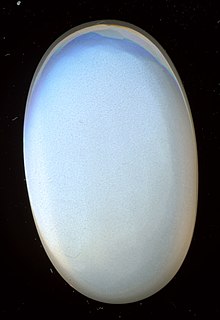Moonstone (mineral)
| Moonstone | |
|---|---|
| Moonstone, unpolished | |
| General and classification | |
| other names |
|
| chemical formula | K [AlSi 3 O 8 ] |
|
Mineral class (and possibly department) |
Silicates and Germanates |
| System no. according to Strunz | see orthoclase |
| Crystallographic Data | |
| Crystal system | monoclinic |
| Crystal class ; symbol | monoclinic prismatic; 2 / m |
| Twinning | Bavenoer, Karlsbader, Manebach twins |
| Physical Properties | |
| Mohs hardness | 6 to 6.5 |
| Density (g / cm 3 ) | 2.56 to 2.59 |
| Cleavage | after {001} perfect, after {010} good |
| Break ; Tenacity | uneven to scalloped |
| colour | colorless, white, yellow, pale shimmer |
| Line color | White |
| transparency | transparent to translucent |
| shine | Glass gloss to pearlescent gloss |
| radioactivity | hardly measurable |
| Crystal optics | |
| Pleochroism | is missing |
| Other properties | |
| Chemical behavior | soluble in HF and alkaline solutions |
| Special features | weak fluorescence (bluish or orange), adularescence , chatoyance with directed light beam |
The moonstone is a variety of orthoclase (synonym: adulara ) and thus belongs to the group of feldspars . It got its name from its shimmering, reminiscent of moonlight .
properties

The moonstone is characterized above all by its adularescence , a bluish-white shimmer that glides over the entire surface of the stone when you move it. Moonstones, which come from the classic country of origin Sri Lanka , are mostly almost completely transparent to milky-white and have a delicate bluish sheen. Stones from India , on the other hand, show a more cloudy basic tone that plays into orange. Cloud-like play of light and shadow can occur.
Education and Locations
As a variety of feldspars, which form mixed rows, cryptoperthitic segregation occurs after the rock mass has cooled down and due to weathering. Due to the refraction and scattering of the light on the segregation lamellas, the moonstone appears cloudy and the overlapping of the refracted light rays create the coveted moonstone effect.
The most important deposits of moonstone are in Sri Lanka (Gangapitiya, Meetiyagoda, Ratnapura).
Moonstones are also found in Australia (Northern Territory, Queensland), Brazil , India , Madagascar , Myanmar (Mogok), Austria ( Spitz ), Tanzania and the USA (Cambria, Cleveland, Coosa County, Danbury / Connecticut, Moonstone Beach / Kingston, North Carolina) found.
Use as a gem stone
Moonstone is used exclusively as a gem stone . It is usually cut into a cabochon , as this shape best accentuates the shine caused by its lamellar structure. In the case of a sharply delimited strip of light, chatoying (cat's eye effect) can be observed. Due to its low hardness and perfect cleavage , moonstone is very sensitive to pressure.
Manipulations and imitations
Real moonstone in gem quality is rare, so it is often offered in the trade imitated by white labradorite . This is especially true for the term “rainbow moonstone”. Other imitations are created using burnt amethyst , synthetic spinel or glass .
The following trade names are in circulation as of 2017:
- Blue moonstone and California moonstone is a misleading name for chalcedony with a bluish glow
- Canadian moonstone is a trade name for albite
- Rainbow moonstone is a blue iridescent white labradorite (feldspar family)
- Black moonstone is an outdated name for labradorite
Esoteric
Esotericists assign the moonstone to the zodiac sign Cancer or Pisces . It is also considered a symbol for Venus (Richardson / Huett), Neptune (Richardson / Huett) or the moon . In German-speaking countries it stands for the month of June.
As a healing stone , moonstone is said to alleviate headaches and gynecological problems ( cycle problems ) and generally strengthen the psyche. There is no scientific evidence for the alleged physical or psychological effects.
See also
literature
- Walter Schumann: Precious stones and gemstones. All kinds and varieties. 1900 unique pieces . 16th, revised edition. BLV Verlag, Munich 2014, ISBN 978-3-8354-1171-5 , pp. 52, 180, 278 .
Web links
- Mineral Atlas: Moonstone (Wiki)
- Moonstone. In: mindat.org. Hudson Institute of Mineralogy, accessed September 23, 2019 .
Individual evidence
- ^ A b Walter Schumann: Precious stones and gemstones. All kinds and varieties. 1900 unique pieces . 16th, revised edition. BLV Verlag, Munich 2014, ISBN 978-3-8354-1171-5 , pp. 180 .
- ↑ Trade name search. In: epigem.de. EPI - Institute for Gemstone Testing, accessed on September 23, 2019 (entry of the relevant trade names required).


